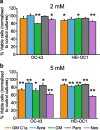Lower ototoxicity and absence of hidden hearing loss point to gentamicin C1a and apramycin as promising antibiotics for clinical use
- PMID: 30787404
- PMCID: PMC6382871
- DOI: 10.1038/s41598-019-38634-3
Lower ototoxicity and absence of hidden hearing loss point to gentamicin C1a and apramycin as promising antibiotics for clinical use
Abstract
Spread of antimicrobial resistance and shortage of novel antibiotics have led to an urgent need for new antibacterials. Although aminoglycoside antibiotics (AGs) are very potent anti-infectives, their use is largely restricted due to serious side-effects, mainly nephrotoxicity and ototoxicity. We evaluated the ototoxicity of various AGs selected from a larger set of AGs on the basis of their strong antibacterial activities against multidrug-resistant clinical isolates of the ESKAPE panel: gentamicin, gentamicin C1a, apramycin, paromomycin and neomycin. Following local round window application, dose-dependent effects of AGs on outer hair cell survival and compound action potentials showed gentamicin C1a and apramycin as the least toxic. Strikingly, although no changes were observed in compound action potential thresholds and outer hair cell survival following treatment with low concentrations of neomycin, gentamicin and paromomycin, the number of inner hair cell synaptic ribbons and the compound action potential amplitudes were reduced. This indication of hidden hearing loss was not observed with gentamicin C1a or apramycin at such concentrations. These findings identify the inner hair cells as the most vulnerable element to AG treatment, indicating that gentamicin C1a and apramycin are promising bases for the development of clinically useful antibiotics.
Conflict of interest statement
Dr. Stefan Fujs and Dr. Gregor Kosec are shareholders of Acies Bio d.o.o. Their work has been funded by Acies Bio d.o.o. Masaaki Ishikawa, Nadia García-Mateo, Alen Čusak, Iris López-Hernández, Marta Fernández-Martínez, Marcus Müller, Lukas Rüttiger, Wibke Singer, Hubert Löwenheim, Luis Martínez-Martínez, Thomas Schimmang, Hrvoje Petković, Marlies Knipper and M. Beatriz Durán-Alonso declare that they have no conflicts of interest or competing financial interests.
Figures





Similar articles
-
Ototoxicity resulting from combined administration of metronidazole and gentamicin.Am J Otol. 1999 Jul;20(4):430-4. Am J Otol. 1999. PMID: 10431882
-
Dissociation of antibacterial activity and aminoglycoside ototoxicity in the 4-monosubstituted 2-deoxystreptamine apramycin.Proc Natl Acad Sci U S A. 2012 Jul 3;109(27):10984-9. doi: 10.1073/pnas.1204073109. Epub 2012 Jun 14. Proc Natl Acad Sci U S A. 2012. PMID: 22699498 Free PMC article.
-
Apramycin and gentamicin resistances in indicator and clinical Escherichia coli isolates from farm animals in Korea.Foodborne Pathog Dis. 2011 Jan;8(1):119-23. doi: 10.1089/fpd.2010.0641. Foodborne Pathog Dis. 2011. PMID: 21214385
-
An update on ototoxicity: from a genetic perspective.J Toxicol Sci. 2025;50(6):245-261. doi: 10.2131/jts.50.245. J Toxicol Sci. 2025. PMID: 40451854 Review.
-
New developments in aminoglycoside therapy and ototoxicity.Hear Res. 2011 Nov;281(1-2):28-37. doi: 10.1016/j.heares.2011.05.008. Epub 2011 May 27. Hear Res. 2011. PMID: 21640178 Free PMC article. Review.
Cited by
-
Wideband Acoustic Reflex Growth in Adults With Cystic Fibrosis.Am J Audiol. 2021 Oct 11;30(3S):825-833. doi: 10.1044/2020_AJA-20-00117. Epub 2021 Mar 4. Am J Audiol. 2021. PMID: 33661027 Free PMC article.
-
Facile and selective N-alkylation of gentamicin antibiotics via chemoenzymatic synthesis.Green Chem. 2022 Nov 17;24(24):9542-9551. doi: 10.1039/d2gc03600b. eCollection 2022 Dec 12. Green Chem. 2022. PMID: 36544494 Free PMC article.
-
Mechanistic plasticity in ApmA enables aminoglycoside promiscuity for resistance.Nat Chem Biol. 2024 Feb;20(2):234-242. doi: 10.1038/s41589-023-01483-3. Epub 2023 Nov 16. Nat Chem Biol. 2024. PMID: 37973888
-
Real-time measurements of aminoglycoside effects on protein synthesis in live cells.Proc Natl Acad Sci U S A. 2021 Mar 2;118(9):e2013315118. doi: 10.1073/pnas.2013315118. Proc Natl Acad Sci U S A. 2021. PMID: 33619089 Free PMC article.
-
Model-Informed Drug Development for Antimicrobials: Translational PK and PK/PD Modeling to Predict an Efficacious Human Dose for Apramycin.Clin Pharmacol Ther. 2021 Apr;109(4):1063-1073. doi: 10.1002/cpt.2104. Epub 2020 Nov 28. Clin Pharmacol Ther. 2021. PMID: 33150591 Free PMC article.
References
-
- Forge, A. & Schacht, J. Aminoglycoside antibiotics. Audiol Neurootol5, 3–22, 13861 (2000). - PubMed

